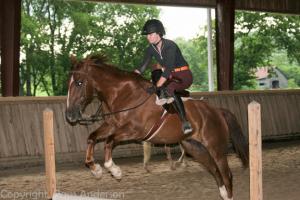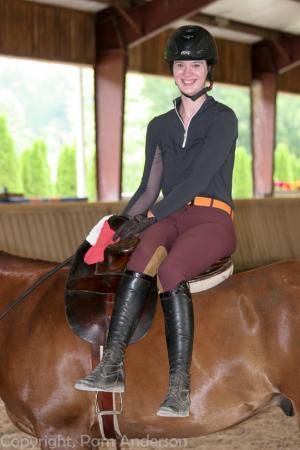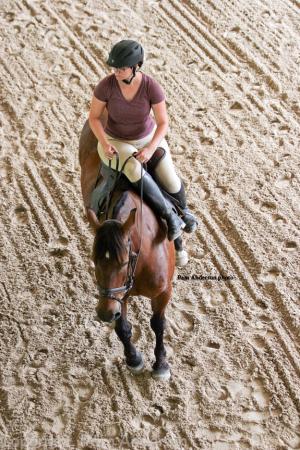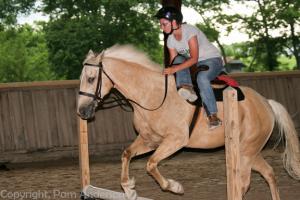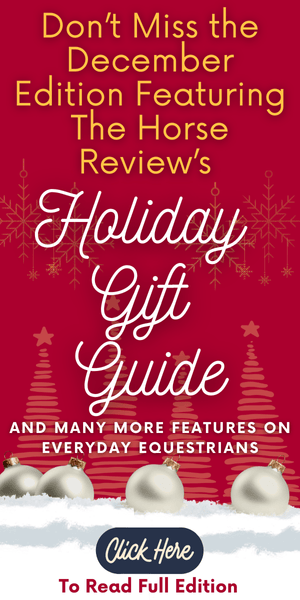By Pam Anderson
Perhaps we can thank costume dramas such as Downton Abbey for the recent resurgence of interest in sidesaddle riding. Such interest has led to sidesaddle classes being incorporated into the Germantown Charity Horse Show. In response to this rekindled interest, The American Sidesaddle Association (ASA) and Circle G Guest Ranch and Event Facility of Lynnville, TN hosted a sidesaddle clinic on June 18, 2017. Education was geared toward the beginning sidesaddle rider, but there was something interesting for everyone, whether they were riding or auditing. The clinicians were very welcoming of all levels of riders. Most riders were novices aside, but several had shown, fox hunted, steeplechased or done other more advanced sidesaddle practices.
Head clinician Maggie Pritchard Herlensky, President of The American Sidesaddle Association, was expertly aided by Kimberly Cornelius and Sue Duncan. Kim Cornelius is from Lexington, Kentucky and is a member of Kentucky Sidesaddle (KYSS). Sue Duncan is from Jamestown, Tennessee and a member of Tennessee Sidesaddle (TenS). Herlensky is from Chillicothe, Ohio and a member of Southern Ohio Ladies Aside (SOLA). ASA is made up of regional clubs from all over the country.
Since several clinic participants came from out of town without horses, Kimber Goodman, owner of Circle G, provided some good horses for them. Two of the lease horses were provided by ASA instructor trainee, Liz Skelton. Liz is also from Lexington, Kentucky where she is a member of Kentucky Sidesaddle.
An hour prior to the 10:00 a.m. start of the clinic, preparation began with saddle fitting. Since many clinic participants had never ridden aside before, their horses were fitted with sidesaddles provided by the Association. The three ladies have quite a collection of sidesaddles from all eras, and they were able to fit all of the horses and riders. Their vintage saddles fit the Thoroughbred quite nicely, but many modern horses are of Spanish descent, like today’s Quarter Horse, or are draft cross and need more modern saddles or those built on a western tree, which have a little more width in the fit. Many horse and rider teams tried more than one saddle looking for a good fit.
After the saddle fitting, new aside riders mounted their horses to get familiar with their tack and the unusual balance. When riding near-side aside, the riders must constantly think about keeping their weight onto the right hip and keeping the right shoulder back so the upper body is square with the horse’s shoulders. After a half hour or so the riders were encouraged to trot and canter if they felt secure enough to do so. After this “trial” stage, teams untacked and returned to the arena for a history lesson before lunch.
The history of sidesaddle riding includes the history of sidesaddles. Clinicians brought out saddles from their collections, starting with the oldest. Sue and Maggie explained how the early sidesaddle riders rode. The history lesson started with describing the chair-style sidesaddle introduced by Anne of Bohemia. This original type of sidesaddle is one in which the rider sat facing sideways with her feet on a platform and a backrest to recline. It was common to have near-facing and off-facing saddles for friends to face each other and socialize with on hunts or hacks. These ladies were not actually controlling their horses but just being led.
As time progressed, ladies wanted more control of their rides and the fixed horn came into existence. This advancement is attributed to Catherine de’ Medici in the 16th century. The nearly vertical horn allows a near-side rider to wrap her right leg around it for balance.
Later, the leaping horn brought a major evolution to the sidesaddle. The leaping horn is a downward curving horn which is positioned above the rider’s left thigh. This horn prevents the rider from being thrown forward, especially on a jump landing. The rider can get quite a secure seat from squeezing the two horns in an emergency grip. The leaping horn got its nickname because it allows a lady to ride out with the hunt and jump fences.
After the history lesson, participants gathered in a large hall for a delicious lunch of grilled hamburgers, baked beans, and potato salad. To complete the lunch, a dessert of homemade vanilla ice cream with fresh bananas and chocolate syrup was served.
During lunch, Maggie spoke about the proper attire for a hunt seat sidesaddle turnout. ASA members proudly showed photos of their recent sidesaddle outings: multiple parades and events, many in historical costume. ASA members are also planning a trip to Breyerfest, July 14-16.
After lunch, the clinic continued with an introduction to jumping, as participants tacked up and warmed up their horses. The group started with trotting poles on the ground, and then progressed to cross-rails and to a small vertical. Riders found that jumping sidesaddle is fairly secure, but feels awkward because of the “slingshot effect” caused by the fixed horn. To adapt to this effect, the riders were encouraged to stay forward on the jump landing a bit longer than they would astride.
Find more information about sidesaddle riding at The American Sidesaddle Association website: americansidesaddleassociation.org and on facebook at American Sidesaddle Association. Anyone interested in learning more about sidesaddle riding is encouraged to contact Maggie Pritchard Herlensky at maggieszoo@hotmail.com.
Perhaps we can thank costume dramas such as Downton Abbey for the recent resurgence of interest in sidesaddle riding. Such interest has led to sidesaddle classes being incorporated into the Germantown Charity Horse Show. In response to this rekindled interest, The American Sidesaddle Association (ASA) and Circle G Guest Ranch and Event Facility of Lynnville, TN hosted a sidesaddle clinic on June 18, 2017. Education was geared toward the beginning sidesaddle rider, but there was something interesting for everyone, whether they were riding or auditing. The clinicians were very welcoming of all levels of riders. Most riders were novices aside, but several had shown, fox hunted, steeplechased or done other more advanced sidesaddle practices.
Head clinician Maggie Pritchard Herlensky, President of The American Sidesaddle Association, was expertly aided by Kimberly Cornelius and Sue Duncan. Kim Cornelius is from Lexington, Kentucky and is a member of Kentucky Sidesaddle (KYSS). Sue Duncan is from Jamestown, Tennessee and a member of Tennessee Sidesaddle (TenS). Herlensky is from Chillicothe, Ohio and a member of Southern Ohio Ladies Aside (SOLA). ASA is made up of regional clubs from all over the country.
Since several clinic participants came from out of town without horses, Kimber Goodman, owner of Circle G, provided some good horses for them. Two of the lease horses were provided by ASA instructor trainee, Liz Skelton. Liz is also from Lexington, Kentucky where she is a member of Kentucky Sidesaddle.
An hour prior to the 10:00 a.m. start of the clinic, preparation began with saddle fitting. Since many clinic participants had never ridden aside before, their horses were fitted with sidesaddles provided by the Association. The three ladies have quite a collection of sidesaddles from all eras, and they were able to fit all of the horses and riders. Their vintage saddles fit the Thoroughbred quite nicely, but many modern horses are of Spanish descent, like today’s Quarter Horse, or are draft cross and need more modern saddles or those built on a western tree, which have a little more width in the fit. Many horse and rider teams tried more than one saddle looking for a good fit.
After the saddle fitting, new aside riders mounted their horses to get familiar with their tack and the unusual balance. When riding near-side aside, the riders must constantly think about keeping their weight onto the right hip and keeping the right shoulder back so the upper body is square with the horse’s shoulders. After a half hour or so the riders were encouraged to trot and canter if they felt secure enough to do so. After this “trial” stage, teams untacked and returned to the arena for a history lesson before lunch.
The history of sidesaddle riding includes the history of sidesaddles. Clinicians brought out saddles from their collections, starting with the oldest. Sue and Maggie explained how the early sidesaddle riders rode. The history lesson started with describing the chair-style sidesaddle introduced by Anne of Bohemia. This original type of sidesaddle is one in which the rider sat facing sideways with her feet on a platform and a backrest to recline. It was common to have near-facing and off-facing saddles for friends to face each other and socialize with on hunts or hacks. These ladies were not actually controlling their horses but just being led.
As time progressed, ladies wanted more control of their rides and the fixed horn came into existence. This advancement is attributed to Catherine de’ Medici in the 16th century. The nearly vertical horn allows a near-side rider to wrap her right leg around it for balance.
Later, the leaping horn brought a major evolution to the sidesaddle. The leaping horn is a downward curving horn which is positioned above the rider’s left thigh. This horn prevents the rider from being thrown forward, especially on a jump landing. The rider can get quite a secure seat from squeezing the two horns in an emergency grip. The leaping horn got its nickname because it allows a lady to ride out with the hunt and jump fences.
After the history lesson, participants gathered in a large hall for a delicious lunch of grilled hamburgers, baked beans, and potato salad. To complete the lunch, a dessert of homemade vanilla ice cream with fresh bananas and chocolate syrup was served.
During lunch, Maggie spoke about the proper attire for a hunt seat sidesaddle turnout. ASA members proudly showed photos of their recent sidesaddle outings: multiple parades and events, many in historical costume. ASA members are also planning a trip to Breyerfest, July 14-16.
After lunch, the clinic continued with an introduction to jumping, as participants tacked up and warmed up their horses. The group started with trotting poles on the ground, and then progressed to cross-rails and to a small vertical. Riders found that jumping sidesaddle is fairly secure, but feels awkward because of the “slingshot effect” caused by the fixed horn. To adapt to this effect, the riders were encouraged to stay forward on the jump landing a bit longer than they would astride.
Find more information about sidesaddle riding at The American Sidesaddle Association website: americansidesaddleassociation.org and on facebook at American Sidesaddle Association. Anyone interested in learning more about sidesaddle riding is encouraged to contact Maggie Pritchard Herlensky at maggieszoo@hotmail.com.
